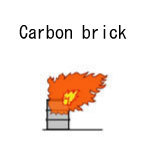| Case Name |
Turf grass fire caused due to scatter from a flare stack |
| Pictograph |

|
| Date |
December 12, 2000 |
| Place |
Kawasaki, Kanagawa, Japan |
| Location |
Chemical factory |
| Overview |
At an emergency shutdown of another plant, the gas turbine (GT) power generator in the ethylene plant was switched to individual operation. The number of revolutions of the GT dropped at that time, and the GT was stopped urgently by the interlock of the GT for which the set value was mistaken. On stopping the GT, the ethylene plant performed an emergency shutdown because there was a power failure. Therefore, gas such as ethylene and propylene was discharged in large quantities and burned at the flare stack. Through this emission of gas, carbon bricks that adhered to the flare stack inside were scattered, and the turf grass was burned by high-temperature carbon.
Carbon brick; the carbonic lump adhered inside the flare stack. |
| Incident |
A flare stack of a petrochemical factory belched a large flame at an emergency shutdown of an ethylene manufacturing plant. High-temperature carbon bricks from the flare stack's upper part burned dry grass near the flare stack. |
| Processing |
Waste and disposal |
| Process Flow |
Fig3.Power supply flow sheet
|
| Substance |
Carbon brick |
| Type of Accident |
Fire |
| Sequence |
At 13:04 on December 12th, 2000, an emergency shutdown was carried out at an ethylene plant due to an emergency stop of a gas turbine (following GT) in the plant. Gas such as ethylene and propylene was discharged through a flare stack, and a lot of black smoke and flames rose from the flare stack.
At 13:05, a sub-contractors worker found dry grass about 30 m away from the flare stack burning and extinguished a fire with a fire extinguisher. |
| Cause |
The gas flow rate to the flare stack suddenly increased by the emergency shutdown of the ethylene plant. Therefore, carbon bricks that adhered inside the flare stack were engulfed in the gas stream, exfoliated, reached a high temperature due to the fire in the flare stack, and fell to the surface of the earth. |
| Response |
The fire at the turf grass was put out with three fire extinguishers. A water sprinkling line at a hazardous material tank near the flare stack was opened, and the tank was cooled. This is a regulated method. |
| Countermeasures |
Confirmation of a set value, including the GT interlock and other instruments, was done after a thorough equipment inspection. It is necessary to carry out double check confirmation of the set value of the interlock by different engineers and at different times.
The turf grass near the flare stack was torn off, and paved with crushed stones. |
| Knowledge Comment |
Even if the countermeasure is taken based on the estimation of various troubles, very simple error of human may cause a trouble. |
| Background |
There were two reasons for the grass fire; one was an emergency shutdown of the ethylene plant, and the other was carbon bricks adhering to the inside of the flare stack.
The causes of the emergency shutdown of the ethylene plant were as follows.
1) A shutdown of a plant using a large amount of electric power occurred. To prevent a reverse current to the Electric Power Company, the GT generator in the ethylene plant was switched to individual operation.
2) In individual operation, the output of the GT generator must be lowered, therefore, the number of revolutions of the GT was temporarily reduced.
3) As excessive lowering of the number of revolutions might lead to major problems, it is stopped with an interlock (IL).
Although the number of revolutions set at IL was originally 95% of normal operation, it had been set at 96% by mistake at the time of the accident. (Refer to Fig3). Therefore, there was a power failure with an emergency shutdown of the ethylene plant. The ethylene plant was shut down due to the mistake in setting of the number of revolutions at IL of the GT.
Adhesion of carbon particles might be caused during the start-up period of the ethylene plant, and this gradually decreases during operation.
Start-up prior to the problem was on November 20 just after a turnaround shutdown, and the carbon particles remained.
Reverse current; An electric current which flows from the user to the electric power company. |
| Incidental Discussion |
GT was not being installed for ethylene manufacture itself, but was installed to cut costs. It might be a very doubtful investment because the main unit is shut down due to such additional equipment. |
| Reason for Adding to DB |
Example of incomplete combustion of a flare stack, which generally has been thought to burn completely. |
| Scenario |
| Primary Scenario
|
Unknown Cause, Occurrence of Abnormal Phenomenon, Poor Value Perception, Poor Safety Awareness, Inadequate Risk Recognition, Carelessness, Insufficient Precaution, Carelessness of Operator, Planning and Design, Poor Planning, No Hypothesis of the Worst Case, Non-Regular Operation, Emergency Operation, Emergency Shutdown, Bad Event, Thermo-Fluid Event, Exfoliation/Scatter, Secondary Damage, External Damage, Fire
|
|
| Sources |
Kawasaki city. Fire fighting station, Prevention division, Peace section. Turf grass fire caused by scattering from the flare stack. Material of the Kawasaki City Complex safety countermeasure committee (2000)
|
| Physical Damage |
About 1.5 square meters of turf grass burned |
| Multimedia Files |
Fig2.Flare stack drawing
|
| Field |
Chemicals and Plants
|
| Author |
KOBAYASHI, Mitsuo (Office K)
TAMURA, Masamitsu (Center for Risk Management and Safety Sciences, Yokohama National University)
|
|